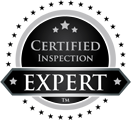 Real Home Inspection Niagara staff know that home maintenance never ends.
Real Home Inspection Niagara staff know that home maintenance never ends.
To keep your home in tip-top shape, homeowners often need to reach for the stars - that is, climb a ladder - to check out what’s happening up high, on the roof or in the eaves.
A ladder is a tool no homeowner should be without. An extension ladder can be useful when washing windows; clearing eavestroughs; mounting security lights; painting; putting up seasonal decorations and replacing loose shingles. It’s also useful for retrieving lost baseballs from eavestroughs, Frisbees and badminton birdies from the roof … if you have children! Step ladders are extremely useful indoors for decorating tasks and for working on small electrical jobs, such as changing light fixtures.
No matter the type of ladder you are using - step, straight, extension or one with variable legs, it’s a good idea to review proper usage before hitting that first step.
RHI Niagara inspectors are up and down ladders all the time. We have some experience, so we would like to offer the following safety tips, shared from Ontario’s Workplace Safety & Prevention Services website. The tips apply both to workplace and home ladder safety.
* Work under the buddy system - do not attempt to carry or place an extension ladder by yourself.
* Wear workboots or shoes with good treads.
* Check the ladder over before using it to make sure it is in good repair.
* Follow manufacturer’s instructions regarding height and weight allowances.
* Place the ladder’s non-skid feet on level footing.
* Lean the ladder against your home at a ratio of 4:1; that is, one foot away from the wall for every four feet of height required, keeping in mind you need at least three rungs above the roof before you anchor your ladder. If your ladder is extended 16 feet high, place it four feet away from the base of the wall.
* Secure the ladder using its safety hooks (or tie it off, if there are no hooks) and ensure both sides are locked. To accomplish this, one person must actually climb the ladder, so use your buddy as an anchor: One person ascends the ladder; one person stands on bottom rung for added anchorage.
* When ascending or descending, use the three-point contact rule: Always have two hands and one foot, or two feet and one hand, in contact with the ladder while you are in motion.
* To transport materials, hoist them or tie to your belt; do not attempt to carry tools up the ladder with you.
* First, never use a step ladder as a straight ladder. Ever.
* Wear workboots or shoes with good treads.
* Choose a CSA-approved ladder with good treads marked into its steps.
* Use on level surface only (perfect for indoor use).
* Extend legs fully and ensure braces are locked.
* If possible, use a CSA-approved step ladder with side rails, as these provide a safer support and enhanced security, since there is always something to hang on to.
* Follow manufacturer’s instructions regarding height and weight, and never use the top of a step ladder as an actual step.
* Use on level surfaces only.
* These ladders are made for extending in awkward places, such as staircases. Ensure heights of each extension are level and that locks are engaged before climbing.
* If this type of ladder is used to create a platform, follow manufacturer’s guidelines for height and weight allowances.
* Other safety tips as above also apply.
RHI Niagara inspectors say most of these tips are just common sense, but of course it never hurts to review your grasp of common sense, before you need to climb the ladder.
A little ladder safety education now can save you from falling to Earth later, when you are trying to reach for the stars.
Book a Real Home Inspection Niagara service by visiting our website at http://www.rhiniagara.com/book-an-inspection, or by calling 905-401-7586. Our office serves the Niagara region and surrounding areas, and is open 24 hours, seven days per week.




I am in the business of rejuvenating and selling properties and Mr. Andrusiw is the only inspector I use.